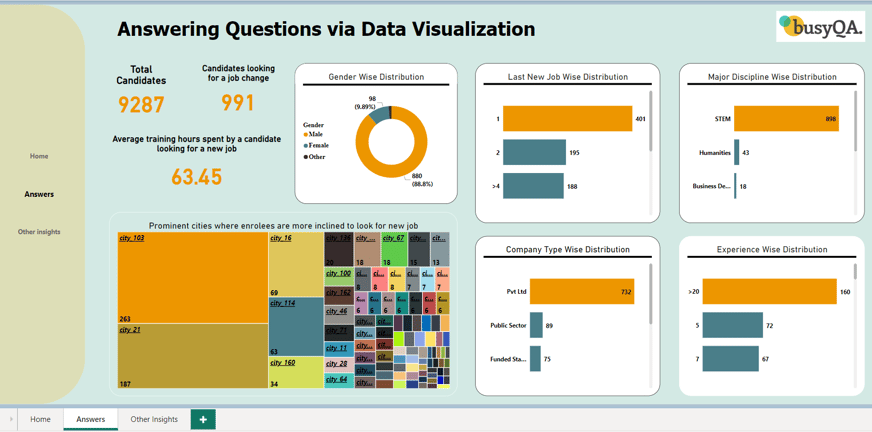HR Analytics
HR analytics is transforming HR operations, enhancing efficiency, and yielding superior outcomes; while historical analytics have relied on manual processes, the emergence of machine learning offers new avenues for predictive insights, exemplified by this project.
8/24/20233 min read
Project Overview
HR analytics is revolutionizing the way human resources departments operate, leading to higher efficiency and better results overall. Although HR departments have been using analytics for years, the collection, processing, and analysis of data have predominantly been manual. Given the nature of human resources dynamics and HR key performance indicators (KPIs), this manual approach has constrained HR operations. It is surprising that HR departments have only recently recognized the utility of machine learning in this domain. This project provides an opportunity to explore predictive analytics in the HR field.
Questions to Address
During the analysis, we will explore the following questions to gain valuable insights:
Are there any prominent cities where enrolees are more inclined to look for a new job?
Do enrolees with lower years of experience tend to seek new job opportunities?
Do enrolees looking for a new job spend a significant amount of time in training?
Do enrolees looking for new jobs frequently change their employment or spend considerable time in their last job?
Are employees from the private sector more inclined towards finding new jobs?
Are males more inclined to seek new job opportunities compared to females?
Are enrolees from non-STEM backgrounds more likely to look for a new job?
Are there any other specific insights that can help us understand the drivers for job change?
Task 1: Data Analysis and Visualization
To address the problem statement and answer the questions mentioned above, we will follow these steps:
Import the train data into a Python Jupyter Notebook and establish a connection.
Use Python's pandas package and basic Python for data wrangling, cleaning, and manipulation, including:
Checking for duplicates in the data.
Applying outlier treatment techniques.
Handling missing values appropriately.
Conducting univariate and bivariate analysis to gain insights.
Creating a correlation matrix to identify relationships between variables.
Utilize Python packages to provide answers to the questions and plot charts for univariate and bivariate analysis using the Matplotlib/Seaborn package.
Problem Statement
BusyQA, a training institute specializing in analytics and data science, aims to expand its business to manpower recruitment in the data science domain. The company receives a large number of signups for its training programs and wants to connect these enrolees with clients looking to hire employees in the analytics field. Before making these connections, it is crucial to identify which candidates are genuinely seeking new employment opportunities. BusyQA possesses student information related to demographics, education, experience, and training features.
The goal of this project is to design a model that utilizes the current credentials, demographics, and experience of enrolees to predict the probability of an enrolee seeking a new job.
Task 2: Dashboard Creation with Power BI/Tableau
Using Power BI or Tableau, clean and prepare the Excel file generated from Task 1. Create a two-page report/dashboard that showcases the HR analysis. Ensure the dashboard effectively communicates the insights derived from the data.


Task 3: Predictive Modeling with Machine Leaning models
Employed Decision Tree algorithms to build a machine learning model with 90% accuracy, enabling accurate prediction of the number of future candidates who will be seeking new job opportunities after enrolling in the BusyQA Data Analyst Course.
Collaborated with a team of professionals to gather, analyze, and interpret data related to candidate enrollment and job search trends, contributing to evidence-based decision-making and strategic planning.
Presented findings and recommendations based on comprehensive data analysis, highlighting the potential impact of the BusyQA Data Analyst Course on candidates' career trajectories, aiding in the development of targeted strategies to enhance job placement opportunities by 30% for enrolled candidates.
Conclusion
In conclusion, BusyQA's HR Analytics project leveraged data analysis and machine learning to enhance their data science recruitment process. Through tasks like data cleaning, visualization, and predictive modeling, the project illuminated key factors influencing job-seeking behavior among enrollees. A user-friendly dashboard was created using Power BI/Tableau to effectively communicate these insights. The collaborative effort among professionals ensured a comprehensive understanding of candidate trends. By achieving a 90% accuracy in predictive modeling, the project enables BusyQA to proactively identify potential job seekers. This data-driven approach not only optimizes recruitment strategies but also contributes to targeted efforts, potentially increasing job placement opportunities by 30%. The project underscores the transformative role of analytics and technology in modernizing HR practices for better results.